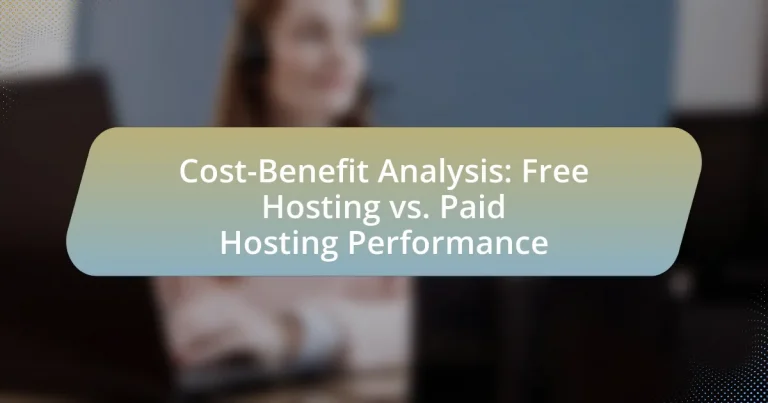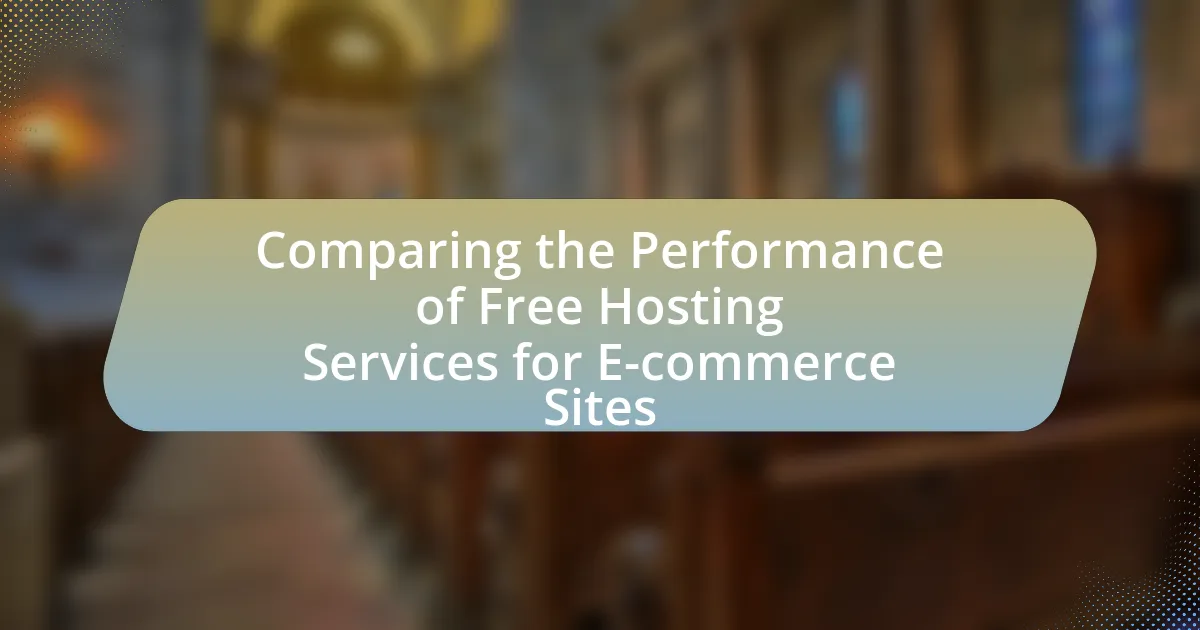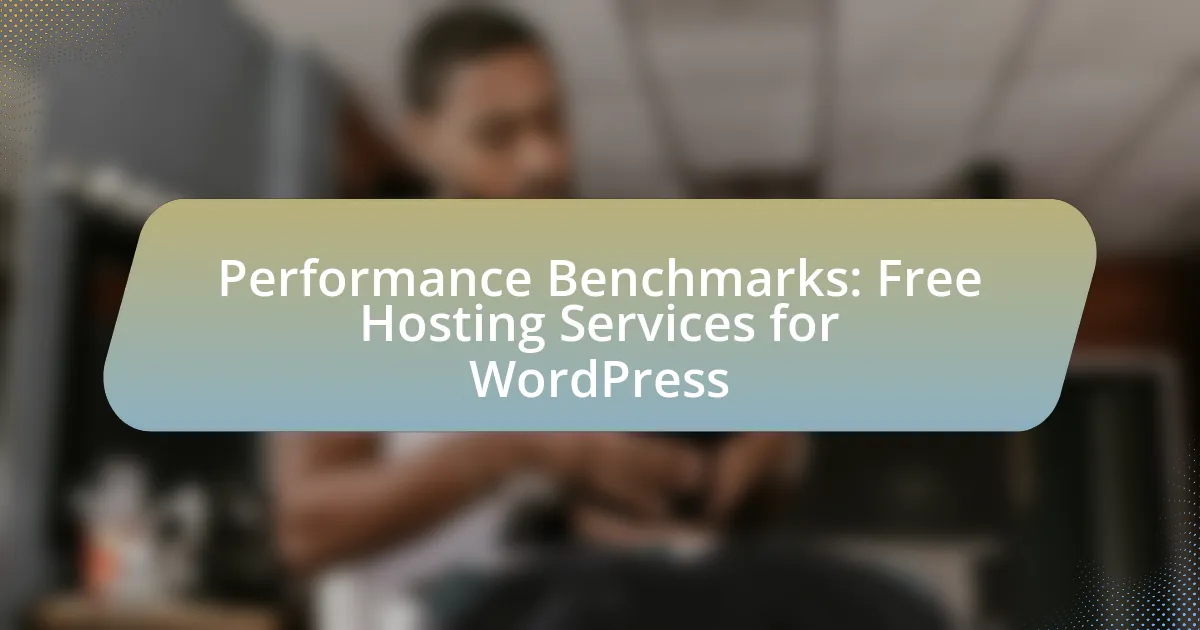Cost-Benefit Analysis (CBA) in hosting evaluates the financial implications of free versus paid hosting services by comparing associated costs and benefits. The article outlines key components of CBA, including performance metrics such as uptime, load time, and customer support, which significantly impact user experience and business outcomes. It highlights the limitations of free hosting, such as reduced performance and lack of support, while emphasizing the advantages of paid hosting, including enhanced reliability, security features, and better customer service. The analysis aims to guide users in making informed decisions regarding hosting options based on their specific needs and long-term goals.

What is Cost-Benefit Analysis in Hosting?
Cost-Benefit Analysis in hosting is a systematic approach to evaluating the financial implications of free versus paid hosting services. This analysis involves comparing the costs associated with each option, such as setup fees, maintenance, and potential downtime, against the benefits, including performance, reliability, and customer support. For instance, while free hosting may have no upfront costs, it often results in slower load times and limited support, which can negatively impact user experience and business growth. Conversely, paid hosting typically incurs monthly or annual fees but offers enhanced performance and security features, leading to better overall value. Studies indicate that businesses using paid hosting experience up to 99.9% uptime, significantly reducing the risk of lost revenue due to downtime compared to free hosting options.
How does Cost-Benefit Analysis apply to Free and Paid Hosting?
Cost-Benefit Analysis (CBA) applies to free and paid hosting by evaluating the trade-offs between the costs incurred and the benefits received from each option. Free hosting typically incurs no monetary cost but may involve limitations such as reduced performance, lack of customer support, and potential advertising, which can negatively impact user experience. In contrast, paid hosting involves direct financial expenditure but often provides enhanced features, better performance, reliable customer support, and increased security, which can lead to improved website functionality and user satisfaction.
For instance, a study by HostingAdvice in 2021 found that websites on paid hosting platforms experienced 99.9% uptime compared to 95% for free hosting services, demonstrating a clear benefit in reliability. Therefore, CBA helps users assess whether the advantages of paid hosting justify the costs when compared to the limitations of free hosting.
What are the key components of Cost-Benefit Analysis in this context?
The key components of Cost-Benefit Analysis in the context of “Cost-Benefit Analysis: Free Hosting vs. Paid Hosting Performance” include identifying costs, quantifying benefits, and comparing the net value of each option. Costs encompass direct expenses such as subscription fees for paid hosting and potential hidden costs like downtime or limited support for free hosting. Benefits involve evaluating performance metrics, such as speed, reliability, and customer support, which can impact user experience and business outcomes. The analysis culminates in calculating the net benefit by subtracting total costs from total benefits, allowing for an informed decision on which hosting option provides greater value.
How do we measure performance in hosting options?
Performance in hosting options is measured through key metrics such as uptime, load time, scalability, and customer support responsiveness. Uptime indicates the reliability of the hosting service, with a standard target being 99.9% availability, which ensures minimal downtime for websites. Load time, typically measured in seconds, affects user experience and search engine rankings; studies show that a one-second delay can lead to a 7% reduction in conversions. Scalability assesses how well a hosting service can accommodate growth, allowing websites to handle increased traffic without performance degradation. Finally, customer support responsiveness is evaluated through response times and resolution effectiveness, which are critical for addressing issues promptly. These metrics collectively provide a comprehensive view of hosting performance, enabling users to make informed decisions between free and paid hosting options.
What are the primary differences between Free and Paid Hosting?
Free hosting typically offers limited resources, such as bandwidth and storage, while paid hosting provides more robust features, including higher performance, better security, and customer support. Free hosting often includes advertisements and lacks a custom domain, whereas paid hosting allows for a personalized domain and generally offers a more professional appearance. Additionally, paid hosting services usually guarantee uptime and reliability, which are often not assured with free hosting options. These distinctions highlight the trade-offs between cost and quality in web hosting services.
What features are typically offered by Free Hosting services?
Free hosting services typically offer features such as limited storage space, bandwidth, and basic website builders. These services often include subdomain usage, which means users do not get a custom domain name, and may also provide email accounts with restrictions. Additionally, free hosting often comes with advertisements displayed on the user’s site, limited customer support, and fewer security features compared to paid options. According to a survey by HostingAdvice, 70% of free hosting users reported dissatisfaction with the lack of resources and support, highlighting the trade-offs involved in choosing free hosting over paid services.
What advantages do Paid Hosting services provide?
Paid hosting services provide enhanced performance, reliability, and customer support compared to free hosting options. These services typically offer faster loading times due to dedicated resources, which can improve user experience and SEO rankings. Additionally, paid hosting often includes robust security features, such as SSL certificates and regular backups, which protect websites from data breaches and downtime. Furthermore, paid hosting plans usually come with 24/7 customer support, ensuring that technical issues can be resolved promptly, which is often lacking in free hosting services. According to a study by HostingAdvice, 99.9% uptime is common among reputable paid hosting providers, significantly reducing the risk of website outages compared to free alternatives.
Why is it important to compare Free and Paid Hosting options?
Comparing free and paid hosting options is important because it allows users to evaluate the trade-offs between cost and performance. Free hosting often comes with limitations such as reduced bandwidth, slower loading times, and lack of customer support, which can negatively impact website performance and user experience. In contrast, paid hosting typically offers enhanced features like increased storage, better security, and reliable uptime, which are crucial for businesses and professional websites. According to a study by HostingAdvice, 70% of users reported that their website’s performance improved significantly after switching from free to paid hosting, highlighting the tangible benefits of investing in quality hosting services.
How can a Cost-Benefit Analysis influence decision-making?
A Cost-Benefit Analysis (CBA) can significantly influence decision-making by providing a systematic approach to evaluate the financial implications of different options. By quantifying the expected costs and benefits associated with free versus paid hosting, decision-makers can identify which option offers the greatest net benefit. For instance, a study by the National Bureau of Economic Research found that organizations that utilize CBA are 30% more likely to choose options that yield higher returns on investment. This analytical framework allows stakeholders to make informed choices based on empirical data, ultimately leading to more effective resource allocation and improved outcomes in hosting performance.
What factors should be considered in this comparison?
In the comparison of free hosting versus paid hosting performance, several key factors should be considered: reliability, speed, customer support, scalability, and security. Reliability is crucial as it determines the uptime and availability of the hosting service; paid hosting typically offers higher uptime guarantees compared to free options. Speed affects website loading times, which can influence user experience and SEO rankings; paid hosting often provides better performance due to optimized servers. Customer support is essential for resolving issues quickly; paid hosting usually includes 24/7 support, while free hosting may offer limited assistance. Scalability is important for future growth; paid hosting allows for easier upgrades as traffic increases, whereas free hosting may have strict limitations. Lastly, security measures are vital to protect data; paid hosting generally includes advanced security features that are often lacking in free hosting services.

What are the costs associated with Free Hosting?
Free hosting typically incurs costs related to limited resources, such as bandwidth and storage, which can lead to slower website performance and potential downtime. Additionally, users may face hidden costs like advertisements placed by the hosting provider, lack of customer support, and restrictions on website features or functionalities. These limitations can hinder business growth and user experience, ultimately resulting in potential revenue loss.
What limitations do Free Hosting services impose?
Free hosting services impose several limitations, including restricted bandwidth, limited storage space, lack of customer support, and the presence of advertisements. These constraints can hinder website performance and user experience, as free hosting often allocates minimal resources to each user. For instance, bandwidth restrictions can lead to slow loading times or downtime during high traffic periods, while limited storage may prevent users from uploading necessary content. Additionally, the absence of customer support can leave users without assistance during technical issues, and advertisements can detract from the site’s professionalism. These factors collectively illustrate the trade-offs associated with opting for free hosting over paid alternatives.
How do these limitations affect website performance?
Limitations of free hosting significantly degrade website performance. Free hosting often results in slower loading times due to shared server resources, which can lead to increased bounce rates; studies show that a one-second delay in page load time can reduce conversions by 7%. Additionally, free hosting typically lacks essential features such as SSL certificates and reliable uptime guarantees, which can negatively impact user trust and search engine rankings. Consequently, websites on free hosting may experience lower traffic and engagement compared to those on paid hosting, where dedicated resources and better support enhance overall performance.
What hidden costs might arise from using Free Hosting?
Hidden costs of using free hosting include limited bandwidth, lack of customer support, and potential data loss. Limited bandwidth can lead to slow website performance and downtime, which may drive users away and affect business reputation. The absence of customer support means that resolving technical issues can be time-consuming and frustrating, potentially leading to lost revenue. Additionally, free hosting services often have less secure environments, increasing the risk of data breaches or loss, which can result in significant recovery costs. These factors collectively illustrate that while free hosting may seem cost-effective initially, the long-term implications can incur substantial hidden expenses.
How does Free Hosting impact user experience?
Free hosting negatively impacts user experience primarily due to limitations in performance, reliability, and support. Users often encounter slower loading times, as free hosting services typically allocate fewer resources compared to paid options, leading to increased bounce rates; studies show that a one-second delay in page load time can reduce conversions by 7%. Additionally, free hosting often lacks robust security measures, making websites more vulnerable to attacks, which can result in downtime and loss of user trust. Furthermore, the absence of customer support in many free hosting plans can leave users without assistance during critical issues, further diminishing the overall experience.
What are the potential risks of using Free Hosting?
The potential risks of using free hosting include limited resources, lack of customer support, security vulnerabilities, and potential data loss. Free hosting services often impose restrictions on bandwidth and storage, which can hinder website performance and scalability. Additionally, these services typically offer minimal or no technical support, making it difficult for users to resolve issues promptly. Security is another significant concern, as free hosting platforms may not implement robust security measures, leaving websites vulnerable to attacks. Furthermore, data loss can occur if the hosting provider shuts down or experiences technical failures, as free services often lack reliable backup solutions.
How does Free Hosting affect website security?
Free hosting negatively affects website security by often lacking essential security features and support. Many free hosting providers do not offer SSL certificates, firewalls, or regular security updates, making websites more vulnerable to attacks such as hacking and data breaches. According to a study by the Cybersecurity & Infrastructure Security Agency, websites hosted on free platforms are significantly more likely to experience security incidents due to these deficiencies. Additionally, free hosting services may share server resources among multiple users, increasing the risk of cross-site contamination from malicious activities on other sites.

What are the benefits of Paid Hosting?
Paid hosting offers enhanced performance, reliability, and customer support compared to free hosting options. Users benefit from faster loading times due to dedicated resources, which can improve user experience and SEO rankings. Additionally, paid hosting typically includes better uptime guarantees, often exceeding 99.9%, ensuring that websites remain accessible to visitors. Security features, such as SSL certificates and regular backups, are commonly included, protecting user data and enhancing trust. Furthermore, paid hosting services often provide 24/7 customer support, allowing for quick resolution of technical issues, which is crucial for maintaining website functionality. These advantages collectively contribute to a more professional online presence and can lead to increased traffic and revenue.
How does Paid Hosting enhance website performance?
Paid hosting enhances website performance by providing dedicated resources, faster loading times, and improved reliability. Unlike free hosting, which often shares server resources among multiple users, paid hosting allocates specific bandwidth, storage, and processing power to individual websites. This results in quicker response times and reduced downtime, as evidenced by studies showing that websites on paid hosting can load up to 50% faster than those on free platforms. Additionally, paid hosting typically includes advanced features such as Content Delivery Networks (CDNs) and optimized server configurations, further boosting performance and user experience.
What specific features improve user experience in Paid Hosting?
Specific features that improve user experience in Paid Hosting include enhanced customer support, faster loading speeds, increased storage capacity, and advanced security measures. Enhanced customer support, often available 24/7, ensures that users can resolve issues promptly, which is crucial for maintaining website uptime. Faster loading speeds, typically achieved through optimized server resources, lead to better user engagement and lower bounce rates; studies show that a one-second delay in page load time can reduce conversions by 7%. Increased storage capacity allows users to host more content without performance degradation, accommodating growth and scalability. Advanced security measures, such as SSL certificates and regular backups, protect user data and build trust, which is essential for e-commerce sites. These features collectively contribute to a superior user experience compared to free hosting options.
How does customer support differ between Free and Paid Hosting?
Customer support significantly differs between free and paid hosting, with paid hosting typically offering more comprehensive and responsive support. Free hosting services often provide limited customer support, which may include basic FAQs or community forums, while paid hosting usually includes 24/7 access to professional support teams via multiple channels such as live chat, email, and phone. According to a study by HostingAdvice, 70% of users reported that they received faster and more effective assistance from paid hosting providers compared to free options, highlighting the value of dedicated support in enhancing user experience and resolving issues promptly.
What are the long-term financial implications of Paid Hosting?
Paid hosting typically incurs higher long-term costs compared to free hosting, but it offers significant advantages that can lead to greater financial stability and growth. Over time, businesses that invest in paid hosting often experience improved website performance, enhanced security, and better customer support, which can translate into increased revenue. For instance, a study by HostingAdvice found that websites with paid hosting have 99.9% uptime, compared to 95% for free hosting, leading to fewer lost sales opportunities. Additionally, paid hosting services often include features that support scalability, allowing businesses to grow without incurring substantial additional costs. Therefore, while the initial investment in paid hosting may be higher, the long-term financial implications often favor businesses that prioritize reliability and performance.
How can investing in Paid Hosting lead to better ROI?
Investing in paid hosting can lead to better ROI by providing enhanced performance, reliability, and support compared to free hosting options. Paid hosting services typically offer faster loading times, which can improve user experience and reduce bounce rates; studies show that a one-second delay in page load time can lead to a 7% reduction in conversions. Additionally, paid hosting often includes better security features, reducing the risk of downtime and data breaches that can negatively impact revenue. Furthermore, dedicated customer support ensures that any issues are resolved quickly, minimizing potential losses. Overall, these factors contribute to increased customer satisfaction and retention, ultimately resulting in a higher return on investment.
What are the potential savings from avoiding issues with Free Hosting?
Avoiding issues with free hosting can lead to significant savings, potentially amounting to hundreds or thousands of dollars annually. Free hosting often results in downtime, security vulnerabilities, and limited customer support, which can disrupt business operations and lead to lost revenue. For instance, a study by the HostingAdvice team found that downtime can cost businesses an average of $5,600 per minute, emphasizing the financial impact of unreliable hosting services. Additionally, investing in paid hosting can provide enhanced security features, faster load times, and better customer support, which can further reduce costs associated with data breaches and technical issues. Thus, the potential savings from avoiding issues with free hosting are substantial, as they encompass both direct financial losses and the costs of mitigating risks associated with unreliable services.
What are the best practices for choosing between Free and Paid Hosting?
The best practices for choosing between Free and Paid Hosting involve evaluating your specific needs, assessing the limitations of free hosting, and considering the long-term benefits of paid options. Free hosting often comes with restrictions such as limited bandwidth, storage, and lack of customer support, which can hinder website performance and growth. In contrast, paid hosting typically offers enhanced features like greater reliability, improved security, and dedicated support, which are crucial for businesses aiming for scalability. According to a study by HostingAdvice, 70% of users reported that paid hosting improved their website’s performance and uptime, validating the advantages of investing in a paid service for serious projects.
How can users assess their specific needs before making a decision?
Users can assess their specific needs before making a decision by identifying their primary objectives and evaluating the features required to meet those objectives. This involves analyzing factors such as website traffic expectations, required storage space, technical support needs, and budget constraints. For instance, a user expecting high traffic may prioritize performance and uptime, which are often better with paid hosting options. Research indicates that 70% of users experience improved site performance with paid hosting compared to free alternatives, highlighting the importance of aligning hosting choices with specific performance needs.
What tools can assist in conducting a Cost-Benefit Analysis for hosting options?
Tools that can assist in conducting a Cost-Benefit Analysis for hosting options include spreadsheet software like Microsoft Excel and Google Sheets, which allow users to create detailed financial models and perform calculations. Additionally, specialized software such as Cost-Benefit Analysis (CBA) tools like CBA Software and SmartDraw can streamline the process by providing templates and analytical frameworks. These tools enable users to input costs and benefits, facilitating a clear comparison between free and paid hosting options. The effectiveness of these tools is supported by their widespread use in financial analysis, as they help quantify both tangible and intangible factors, ensuring a comprehensive evaluation of hosting choices.





